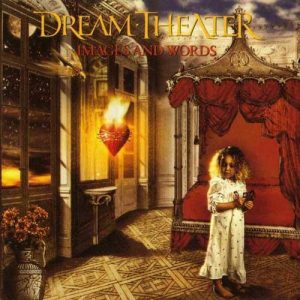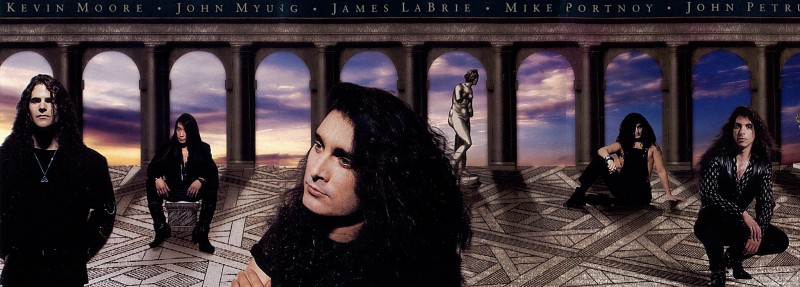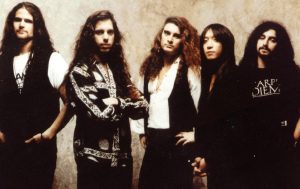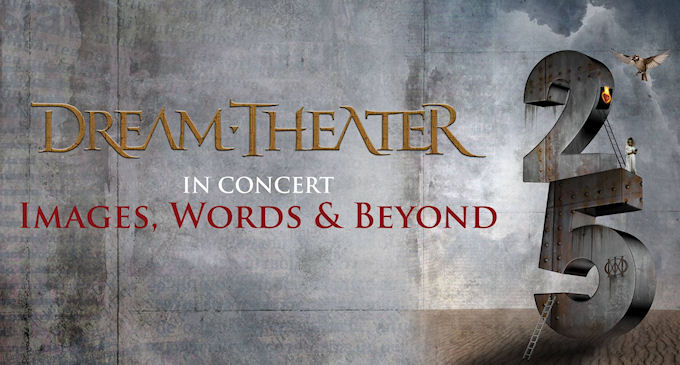
Dream Theater | Images And Words 25th Anniversary Retrospective
Label: ACTO Records
Release Year: 1992
Country: USA/Canada
Genre: Progressive Metal
Band Members – Iamges And Words Lineup
James Labrie – Vocals
John Myung – Bass
John Petrucci – Guitars
Mike Portnoy – Drums
Kevin Moore – Keyboards
Track Listing
Pull Me Under – Kevin Moore 8:14
Another Day – John Petrucci 4:23
Take the Time – Dream Theater 8:21
Surrounded – Kevin Moore 5:30
Metropolis—Part I: ‘The Miracle and the Sleeper – John Petrucci 9:32
Under a Glass Moon – John Petrucci 7:03
Wait for Sleep – Kevin Moore 2:31
Learning to Live – John Myung 11:30
Contact Links
Dream Theater
Dream Theater Official Website
Dream Theater Official Facebook Page
Dream Theater Official Twitter
Dream Theater Official YouTube Channel
Mike Portnoy
Mike Portnoy Official Facebook Page
Kevin Moore
Kevin Moore Official Facebook Page
Prog@Teamrock Images And Words Cover Story
Prog@Teamrock Images And Words Cover Story

The year 2017 sees Dream Theater celebrate the 25 th Anniversary of their ICONIC sophomore album, and the album that is credited for saving the entire progressive rock and metal genres from extinction Images And Words. The band are even doing an entire world tour to celebrate this monumental milestone in recorded music history. To many they looked upon this release as nothing short of a ‘Miracle’.
What Was Happening In 1992 ?
The conditions for a successful metal band were very grim in 1992 to say the least. In America the nation music station MTV had all but abandoned the heavy metal genre in a nutshell. They would trade heavy metal in for bands out of Seattle Washington like Nirvana, Pearl Jam, Tad, Green River and bands like Stone Temple Pilots and Smashing Pumpkins on the Grunge Rock side. They would also cater to more of the Hip Hop R&B with bands like Cypress Hill, Boys 2 Men, etc …
Exceptions to this were bands like Soundgarden, Alice In Chains, White Zombie, Corrosion of Conformity, Pantera, a new upstart band TOOL and Dream Theater. You had Dallas’ Z-Rock nationally syndicate a full 24/7 metal format both on AM & FM stations throughout the United States and Canada and KNAC from Los Angeles attempt to nationally syndicate a full heavy metal format nationally as well. Another thing you would of thought was working against a band like Dream Theater was the fact that in North America progressive rock music had seem almost entirely dead since the late 1970’s.
As a matter of fact Prog Rock became the PORN of rock in a way that most prog purists in North America were at one point ashamed of purchasing progressive rock albums in the shops at the time. Both progressive rock and metal bands had been relegating basically from stadiums and arenas to small theaters and night clubs. However in what seemed like the ‘Perfect Storm’ working against the band, Dream Theater not only thrived in this atmosphere but flourished.

Images And Words – The History
After a lack luster reception 3 years earlier with their When Day And Dream Unite, Dream Theater knew there would have to be a change. Little did they know it was going to be a change at the Lead Vocalist position.
After Charlie Dominici’s departure from Dream Theater, the band auditioned nearly 200 people across the nation including former Fates Warning vocalist John Arch, before James LaBrie, then of the Canadian glam metal band Winter Rose, sent the band an audition tape. After a short jam session, he was named Dream Theater’s new lead singer, and remained so ever since.
With James LaBrie on board, the band was signed to a seven-album contract by ATCO Records, which by the way also signed Pantera, and shortly after began recording their new album in late 1991. The lead single, “Pull Me Under”, gained the band considerable commercial success with its airplay on MTV and radio, garnering them a top 10 hit on Billboard’s Hot Mainstream Rock Tracks chart. When the album was released, it sold at a steady pace, helped by an extensive world tour.
Dream Theater originally intended to release a double album, but this was rejected by ATCO, causing several songs to be omitted from the album. One of these songs, “A Change of Seasons”, would later be re-recorded by the band and released on an EP of the same name in 1995.
The song “Take the Time” includes samples from Kurtis Blow’s “Christmas Rappin'” (“Hold it now”), Frank Zappa’s “Dancin’ Fool” (“Wait a minute”), and Public Enemy’s “Power to the People”, (“Come on”). James LaBrie had appeared as a guest vocalist on Fates Warning’s 1991 album Parallels, for which the band was credited as “Dream Theatre” in the “special thanks” of the album’s credits. Dream Theater responded by thanking “Fatez Warning” in the credits of Images and Words.
Images and Words was played in its entirety on several occasions during the European leg of the 2007 “Chaos in Motion” tour, in celebration of its 15th anniversary. On July 7, 2012, at a concert in Austin, Texas, the songs “Pull Me Under”, “Another Day”, and “Metropolis” were performed as an encore to celebrate the album’s 20th anniversary. Additionally, “Surrounded” was performed during the main set.
In 1993 Dream Theater Live At The Marquee would include 3 songs from Images And Words those include Metropolis Pt 1 – ‘The Miracle And The Sleeper’ , Another Day and Pull Me Under.
In 1998 Dream Theater’s Once In A Livetime live album would feature ‘Take The Time’, Pull Me Under’, Metropolis Pt 1 – ‘The Miracle And The Sleeper’ and ‘Learning To Live’ from Images And Words.
In 1999 , due to the insane popularity of ‘Metropolis Pt 1 – The Miracle And The Sleeper’, Dream Theater would release a entire and ambitious concept album inspired by Metropolis Pt 1 – The Miracle And The Sleeper affectionately titled ‘Metropolis Pt 2 – Scenes From A Memory’.
In 2000, Dream Theater would go on to play the entire Metropolis Pt 2 – Scenes From A Memory in New York’s Starland Ballroom. This would be filmed for the band’s first ever DVD concert titled Metropolis Pt 2 – Scenes From New York. A special reworked edition to Metropolis Pt 1 – The Miracle And The Sleeper would be featured and called Metropolis 2000 – The Miracle And The Sleeper along with Learning To Live.
In 2008 , as a tongue and cheek humorous gesture towards the moderately successful ‘Pull Me Under’, Dream Theater would release Greatest Hit (…And 21 Other Pretty Cool Songs) . Then-drummer Mike Portnoy explained in the album’s booklet that the selection of songs were carefully made in order to appease both the newcomer and the already existing fan by offering up different versions of songs on other albums to “make the newcomer want to buy the albums from whence they came” and to “give different versions of songs already on other albums” to the current fan. He also suggests that a third disc should’ve been included called “The Epic Side”.
In 2013, the album was reissued on vinyl as a limited edition 180 gr. double LP.
In 2017, Dream Theater celebrated the 25th anniversary of Images And Words on the “Images, Words & Beyond” tour in Europe, starting on January 30 at the Auditorium Parco Della Musica in Rome, Italy.

The Album Cover
In a March 2015 interview with Teamrock’s Prog branch, artist Larry Freemantle sat down and answered a few question concerning the iconic cover to Images And Words. The following information is courtesy of Prog @ Teamrock.
Prog@Teamrock :
How did you get involved in the project?
Larry Freemantle
“At the time they were with Elektra, and at that time they didn’t really have an art department. I was with Atlantic and was assigned it like any other project. They had some company they were somehow connected with called Access Images. It was a pre-computer graphics time, and everyone was just getting into computer work. Access Images was one of those companies that did that sort of stuff, before Photoshop became huge. And they had a few people that worked there, so I sort of oversaw that project.”
Prog@Teamrock :
How did you come up with the idea?Larry Freemantle
“The concept of what was on that cover came from the band. I tried to make it look compositionally like an old painting from a design point of view. I remember I met with the band and we sat down and went through everything. They were very hands on in the early days. John Myung was probably the key person I met along with John Petrucci. Kevin Moore and Mike Portnoy were also very much involved too. They were very specific about what should be where on the sleeve. It was just a matter of trying to piece it together. So they wanted a little girl, they wanted the bird flying and that style of room. It was a collage of engravings and illustrations which I thought was pretty cool. The engravings and the room were from old engravings book that we spliced together, and the sky was worked into it too. As for the font, I had that created and hired a calligrapher, John Stevens, as I wanted it to be personalised and to look like a type font.”Prog@Teamrock:
Stylistically, it’s reminiscent of some of the 70s album sleeves. Is that something that you were conscious of?
Larry Freemantle
“Those guys and myself were huge Hipgnosis fans and that it’s pretty obvious. And in fact, later on they actually used Storm Thorgerson to do some the art for their Falling Into Infinity album. I’m a big fan of how that stuff was done pre-computer. The sleeve is a little dated now, simply because you can see how well things are done today. So I look back and think that I could have done it in so many different ways. Those Hipgnosis phenomenal sleeves are beautiful and haven’t dated, and I suppose Images And Words holds up to some degree. I like the fact that it is a collage rather than, say, it being all photographic.”Prog@Teamrock
Who was the girl who features on the cover?
Larry Freemantle
“The girl was somebody that the photographer, Dan Muro, chose and I think he just cast someone for that. It wasn’t anybody specific for the band. I remember that the flaming heart logo was physically created, and they made a model of it and then photographed it.”Prog@Teamrock
How were the band to work with?
Larry Freemantle
“The guys were down to earth and from Long Island, where I’m from, and we were the same age. They were easy going and it’s always easier to work with a new band than someone who has been around for a long time. In the beginning they were so happy just to be doing some of the stuff we were doing, and it wasn’t a big budget job. They were a very serious and professional band right from the start. A lot of bands are like the deer in the headlights when it comes to ideas so their attitude was quite unusual. They were always great when they came to the table as they always had ideas.”
A Breakdown Of Reason – A Track By Track Analysis Of Dream Thetaer’s Images & Words
Pull Me Under
Pull Me Under was the first song and first single off Images And Words. Pull Me Under is by far the band’s most well-known song. Originally titled “Oliver’s Twist” in instrumental form, the song was added to the album late, replacing Don’t Look Past Me. The song catching on in the mainstream surprised the band, as they had written Another Day in hopes of it being a hit single, due to its softer, more melodic nature. According to Mike Portnoy, Pull Me Under’s success is proof that “the fans like balls and chunk”.
Pull Me Under peaked at #10 on the Billboard Hot 200, skyrocketing the popularity of the album. A video was shot from it using stock footage of the band performing along with conceptual footage. The conceptual footage has nothing to do with the song and was created without any input from the band. The character in the video is referred to as both a vampire and a werewolf by members of the band, who admit they don’t understand what the video is about or what its relation to Pull Me Under is.
The song’s success led to Images and Words going Gold in 1995, and it has become the band’s anthem, though they admit they are sick of playing it. The compilation album Greatest Hit (…and 21 Other Pretty Cool Songs)’s name refers to Pull Me Under as the band’s only major mainstream hit. The song was included as an unlockable song in the game Guitar Hero: World Tour as the song the player plays during the credits, and then as a part of an unlocked set taking place in “Valhalla”. It does not include the abrupt ending with the “would melt” lyric in this game.
Another Day
This would be the second song from Images And Words and the second song released as a single for radio play consideration. John Petrucci wrote Another Day about his father, John Petrucci Sr. who was diagnosed with cancer. John Petrucci Sr. would be the subject of another Dream Theater song, Take Away My Pain from Falling Into Infinity following his death. The video for Another Day follows the song’s lyrics, with a father and son spending time together. MRI scans are visible in the background, tying in to the cancer theme.
Another Day is a melodious ballad with pop sensibilities. The song was written to be accessible, and was presented with radio, single and video releases. Another Day does build up to a crescendo, though it never becomes heavy, instead going into a soprano sax solo by Jay Beckenstein from Spyro Gyra. Jay Beckenstein also owned the studio that Images And Words was recorded in. Though Another Day was written to be accessible and a possible hit, it was surpassed surprisingly by Pull Me Under which became the band’s biggest hit.
Despite a single and video, the song never caught on in the mainstream, the video not being used by MTV and the EP release being considered the rarest commercial release by Dream Theater, often fetching large prices on eBay. The video features the young girl who was the model for the cover of Images and Words.
Take The Time
Take the Time is a song by Dream Theater. It is the third song from their second album, Images and Words. Take the Time is the third radio single release from the album and its second video release.
Dream Theater drummer Mike Portnoy said of this song:
“We decided to write a song about everything we’d been going through for the past 3 years – looking for a new singer, a new label and new management – just all the changes we made and all the frustrations we went through, but have it coming from each of our 4 different perspectives. So, we broke it up, and said, ‘Okay, you take the first verse, you take the second verse,’ went away, wrote lyrics about our feelings about all the stuff we were going through, and then put it together. Then we wrote the chorus together. That was the first time we had ever done that, and it’s the only song on the album where the lyrics were actually written by everybody.”
A video was shot for Take the Time and a radio-edit was released, though neither were used. The video is for the most part a performance video with some mild conceptual elements.
The sampled voice saying “Ora che ho perso la vista, ci vedo di piu” used during the song is from the film “Cinema Paradisio”. The voice saying “Wait a minute...” is sampled from the ending of Frank Zappa’s “Dancin’ Fool”, “Hold up!” is sampled from “Christmas Rapping” by Kurtis Blow, and “Come On!” comes from “Power to the People” by Public Enemy.
Take the Time was originally known as “Grab That Feel”.
Surrounded
Surrounded is one of Dream Theater’s more abstract songs. The exact meaning of the lyrics has eluded fans since its release. The song at one time was dedicated to Arthur Ashe, a tennis player who died of AIDS. The general tone of the lyrics is spiritual, though no literal meaning can be ascertained.
Compared to many of the songs on Images and Words, performances of Surrounded have been rare. Dream Theater performed the the song very scarcely, though it has recently seen a rise in popularity. The reason the band hasn’t played it often may be because it is a “Kevin Moore song” though they routinely play other songs he has penned such as Pull me Under. Live performances of the song may vary wildly from the album version, often with extended lengths and atmospheric solos.
On occasion, alternate live versions have heavily quoted the song “Sugar Mice” by Marillion, to the point of James LaBrie even singing some of the lyrics from that song, as well as quoting the guitar solo from the song “Mother” by Pink Floyd. Jordan Rudess is also known to play keytar during live performances of Surrounded. During the Chaos In Motion 2007-2008 tour,
Dream Theater performed an extended version running at 15 minutes.
Of course like most music in relation to people’s individual personalities and moods, the exact meaning of the song could fracture into many different impressions upon the general audience.
Metropolis, Pt. 1 – The Miracle and the Sleeper
Metropolis, also known as Metropolis, Pt 1 – “The Miracle and the Sleeper” or simply Metropolis Pt 1 is a song by Dream Theater. It is the fifth song from their second album, Images and Words. Metropolis is one of the band’s most beloved and popular songs, despite never being a single. The concepts from Metropolis eventually led to the release of Metropolis Pt 2 – Scenes from a Memory in 1999.
The lyrics to Metropolis have been the source of much debate and analysis with Dream Theater fans, with the band themselves being evasive regarding its exact meaning. A popular theory is that it is about the founding of Rome (Metropolis) by two brothers (Romulus and Remus); however, it is an unofficial explanation. The release of Scenes from a Memory, surprisingly enough, complicated matters, with the album continuing some themes (both lyrical and musical) from the song, but having a much more literal story that did not seem to definitively explain the original.
Metropolis is a very progressive and varied song and is one of the heavier songs on Images and Words. The song is most known for its extended instrumental section, which was some of the most difficult and complex music the band had written and performed at that time. As with many progressive songs, the song has multiple sections and changes.
The “Pt 1” in the title was originally added by John Petrucci as a joke, as no sequel was ever intended. However as fans demands began to increase, and the popularity of the song eventually led to a second song being written. That second song was originally conceived as a 20 minute epic originally intended to be on Falling Into Infinity; however, it was cut from the album at an early state, before the song was completed. Lyrics for Metropolis Pt 2 were never written and the only recording of the whole song is a rough rehearsal. However, various sections of the song were worked into Scenes from a Memory, most notably the entirety of Overture 1928, and most of One Last Time.
Metropolis was also known as “Crumbling Metropolis” early on.
The song was originally written when Charlie Dominici was in the band, and was played live at every show in 1989, although this version had a different intro and a slightly shorter outro.
Under A Glass Moon
Under a Glass Moon is a song by Dream Theater. It is the sixth song on their second album, Images and Words. Despite never being released as a single, Under a Glass Moon is one of the band’s more popular songs especially in live sets. It was written by John Petrucci.
This song was the most obvious Easter Egg on the album cover itself.
Under a Glass Moon is one of the heavier songs on Images and Words, known for its signature opening and crunching riff. The song is mid-tempo, and contains one of John Petrucci’s more famous guitar solos.
In a testament to the strange titles Dream Theater songs can have before lyrics are written for them, Under a Glass Moon was originally known as “The Battle of Jimmy Cocoa and Fish-Face”.
Wait For Sleep
Wait for Sleep is a song by Dream Theater. It is the seventh song off their second album, Images and Words. The song is notable for being one of only two songs penned completely by Kevin Moore, the other being Space-Dye Vest from Awake 1994.
The song is said to be about a friend of Kevin Moore’s who he claimed had “a spiritual void” who struggled with her beliefs regarding the death of a friend
Along with Space-Dye Vest, Wait for Sleep is one of only two songs penned completely by Kevin Moore. The song features no drums, guitar or bass, though live performances occasionally use a full-band arrangement.
The song, much like Only a Matter of Time before it, lent a lyric to the title, the line “Where images and words are running deep” is the source of the album’s title.
Performances of Wait for Sleep are somewhat rare, especially since Kevin Moore’s departure from Dream Theater. The band rarely plays the song as it is on the album, usually instead opting for a full band arrangement that fans usually refer to as the acoustic version, due to John Petrucci’s use of acoustic guitar. Some versions, particularly early ones have been known to have been extended in length, usually due to an elaborate intro from Kevin Moore.
Learning To Live
Learning to Live is a song by Dream Theater. It is the 8th and final song off the band’s second album, Images and Words. It is also the longest song on Images And Words.
Through Learning to Live is heavily metaphorical, some sense can be made of it. The song is said to be about the AIDS crisis, which in 1992 was quite prevalent. The opening line “He had no time for pain, no energy for anger” is said to be borrowed from the novel Atlas Shrugged by Ayn Rand, said to be an influence on John Myung.
Learning to Live is the longest and most progressive song on Images and Words and is the band’s first officially released song to go beyond ten minutes long. The song reprises the piano theme from Wait for Sleep, making the songs somewhat of a pair.
Live performances of Learning to Live are quite common, and even when the band does not play the entire song, it is a common element in medleys
It should be noted that Change Of Season’s was suppose to be on Images And Words. When the band released its Images And Words Demos 1989-1991 on the installment of Official Bootlegs in 2005, the original instrumental demo was included. The band would release Change of Seasons in 1995 as a EP with various other live performances. Images And Words also is a real rarity in that it was one of the few progressive rock or metal albums to avoid the second album or ‘sophomore jinx’. Images And Words was like a rebirth for Dream Theater in both lineup and sound for the band. Images and Words was a moderate commercial hit, reaching number 61 on the US Billboard 200 chart. It is also Dream Theater’s only album to be certified gold by the RIAA, and remains their best-selling album to date, selling more than six hundred thousand copies. It is still the bands bestselling album to date.



